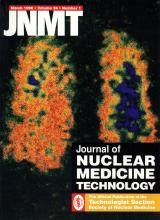Abstract
Objective: No formal study has been done to document the extent of chemical substance use among radiologic science professionals. In this study, baseline data were acquired on prevalence, use patterns and behaviors associated with chemical substance use among a group of technologists that included nuclear medicine, radiography, diagnostic medical sonography, CT, MRI and radiation therapy.
Methods: Copies of a written questionnaire were hand distributed to technologists at five hospitals in a metropolitan statistical area. The survey tool sought prevalence, use and behavioral data in the following drug categories: alcohol, tobacco, sedatives, tranquilizers, stimulants, analgesics, marijuana, inhalants, cocaine, hallucinogens and heroin. Completed surveys were collected in drop boxes and responses were entered into a computer database for analysis.
Results: The response rate for this study was 55.8%. Of this group, 83.5% had used at least one type of drug in their lifetime, and all types of drugs noted on the survey had been used. The top four drug types used, in descending order of use, were alcohol, tobacco, analgesics and marijuana/hashish. Respondents appeared to have the least success in trying to cut down on cigarette use.
Conclusion: This study confirms that radiologic science professionals are users of both licit and illicit chemical substances, and that behavior is influenced by their use. Additional study is warranted to draw a more representative picture of chemical substance use by the profession as a whole and its effects on work-related activities.







